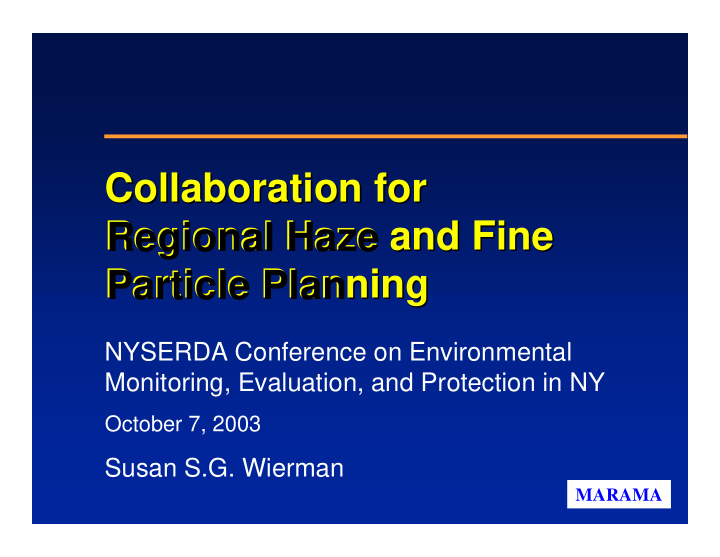



Collaboration for Collaboration for Regional Haze and Fine Regional Haze and Fine Particle Pla Particle Plan ning nning NYSERDA Conference on Environmental Monitoring, Evaluation, and Protection in NY October 7, 2003 Susan S.G. Wierman MARAMA
Topics Topics z Key Regional Haze SIP Requirements z Ten Questions Visibility and PM2.5 Planners Wan t Answered z Regional Collaboration--Visibility SIPs z Current work & next steps MARAMA
Regional Haze SIP Goal Regional Haze SIP Goal “…the prevention of any future, and the remedying of any existing, impairment of visibility in mandatory Class I Federal areas which impairment results from man-made air pollution.” (CAA Sec. 169) MARAMA
Moosehorn Great Gulf Presidential Range Roosevelt Dry River Campobello Lye Brook Acadia Brigantine Class I areas near New York Class I areas near New York
zyxwvutsrqponmlkjihgfedcbaYVUTSRQPONMLKJIHGFEDCBA Fine particles = sulfates + organics + nitrates + ammonium + elemental carbon+ soil dust View from Look Rock, Great Smoky Mtns., TN
Key Regional Haze SIP Key Regional Haze SIP Requirements Requirements z Calculation of Baseline & Natural Visibility Conditions z Reasonable Progress Goals z BART (Best Available Retrofit Technology) z Long-term Strategy (includes control measures needed to achieve goals) MARAMA
Baseline to Natural by 2064 Baseline to Natural by 2064 35 30 0.362 dv/year 0.362 dv/year 25 0.348 dv/year 0.348 dv/year 20 dv 0.270 dv/year 0.270 dv/year 15 0.262 dv/year 0.262 dv/year 0.233 dv/year 0.233 dv/year Shenandoah (VA) 10 B rigantine (NJ) Lye Brook (VT) 5 Acadia (ME) Moosehorn (ME) 0 1980 1990 2000 2010 2020 2030 2040 2050 2060 2070 MARAMA
Sche Sched ule dule z First SIP due ~ 2007 z First increment of progress by 2018 z Five year increments z 2064 natural conditions MARAMA
MARAMA
Regional Contribution Regional Contribution z Large for both sulfates and organic carbon –The principle components of PM 2.5 in the eastern US z All Class I areas are affected by out-of-state sources MARAMA
Basic Questions Basic Questions • What kinds of sources are causing visibility impairment and high PM levels? • Where are those sources located? • What kinds of emissions controls in my state will effectively reduce those emissions? MARAMA
Additional Questions Additional Questions • What help can I get from other states and EPA? • How soon can controls be adopted? • At what cost? • In the mean time, how can I provide informati on to the public? MARAMA
More Detaile d Questions More Detailed Questions • Do we know enough to predict high PM levels and to estimate the results of controls? • Do w e understand enough to identify and control carbon sources? • Should we modify our monitoring network? MARAMA
Great Gulf Lye Brook Acadia New York New York Emissions Affect Class I New York Emissions Affect Class I Areas in Other States Areas in Other States
Other States Affect the Same Areas Other States Affect the Same Areas Massachusetts New Hampshire Connecticut Rhode Island Vermont Maine Acadia Pennsylvania New York Delaware New Jersey Virginia Maryland
Collaboration among Collaboration among z States affecting the area z Tribes z Federal land managers & EPA z Affected sources z The public MARAMA
Pu Pur rp pos oses of es of Reg Regi io onal Proce nal Proces s ss z Identify sources contributing to haze z Set Goals for Class I areas z Coordinate BART determinations z Assess adequacy of control options z Develop regional control measures z Coordinate among regions MARAMA
Regional Planning Orgs. Regional Planning Orgs. z MANE-VU z VISTAS z Midwest RPO z CENRAP z WRAP MARAMA
MANE MANE-V U Members -VU Members z Maine z Pennsylvania z New Hampshire z Delaware z Vermont z Maryland z Massachusetts z District of Columbia z Connecticut z Penobscot Nation z Rhode Island z St. Regis Mohawk Tr. z New York z EPA, NPS, USFS, USF&WS z New Jersey MARAMA
MANE MANE-V -VU S U St aff taff z OTC – Chris Recchia, Exec. Director z NESCAUM – Gary Kleiman, Technical lead z MARAMA – Serpil Kayin, Technical lead MARAMA
Some MANE-VU Products Some MANE-VU Products z Regional Haze summary report z Additional monitoring z CAMNET z Source apportionment study z Inventory improvements z Reports on potential BART sources MARAMA
Current MANE- Current MANE-V U Projects VU Projects z Additional data analysis z Inventory improvements z Model sensitivity analysis z Contribution assessment report z SIP Template z Web-based tools for trajectory analyses & event tracking MARAMA
Next Steps Next Steps z Must reduce SO 2 emissions –Will reduce both urban and rural sulfates –In-state and neighboring state SO 2 reductions greatest impact –Transport rule/multi-p bill essential MARAMA
Other controls ne eded Other controls needed z Year-round NO x reductions z Reduce diesel emissions z Control various kinds of fires and combustion MARAMA
More information More information z http://www.manevu.org/ z http://www.marama.org z http://www.nescaum.org z http://www.epa.gov/oar/visibility/ z http://www2.nature.nps.gov/ard/ MARAMA
Recommend
More recommend